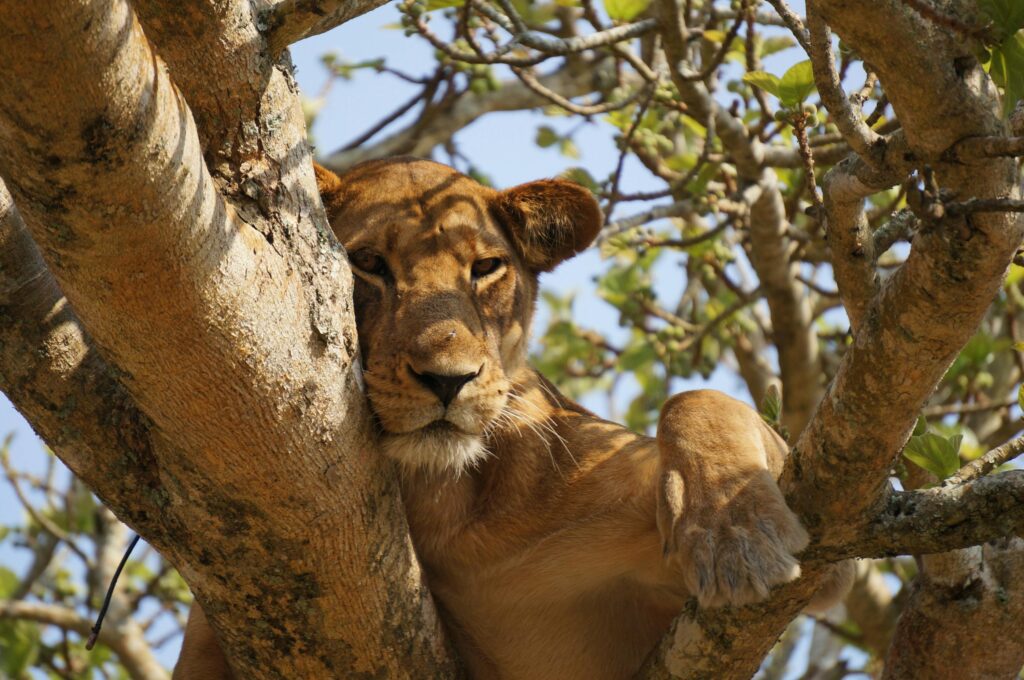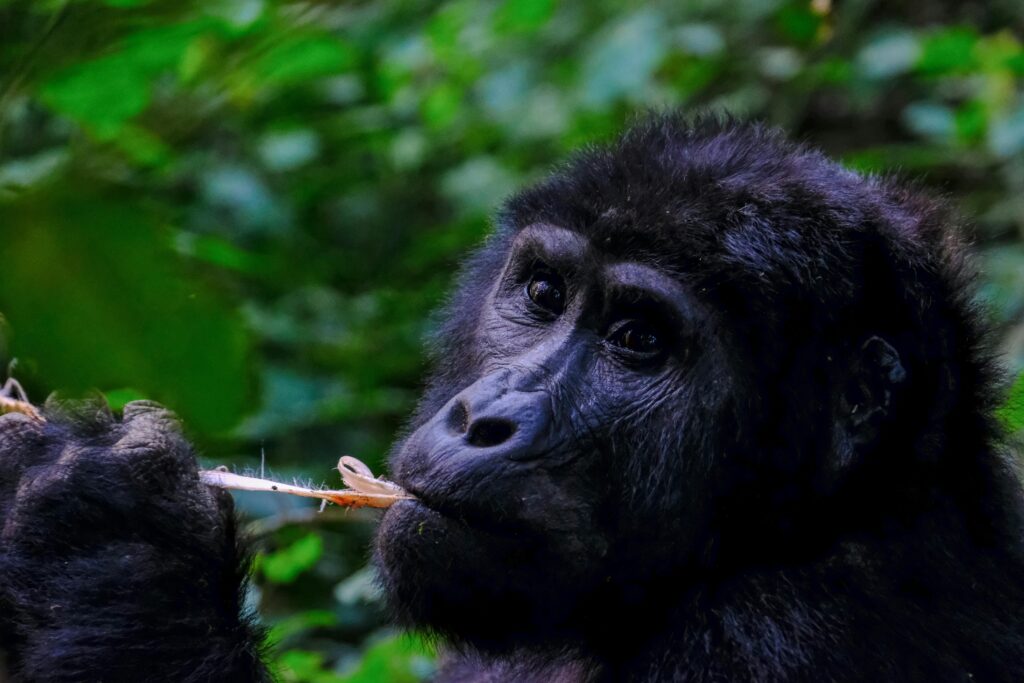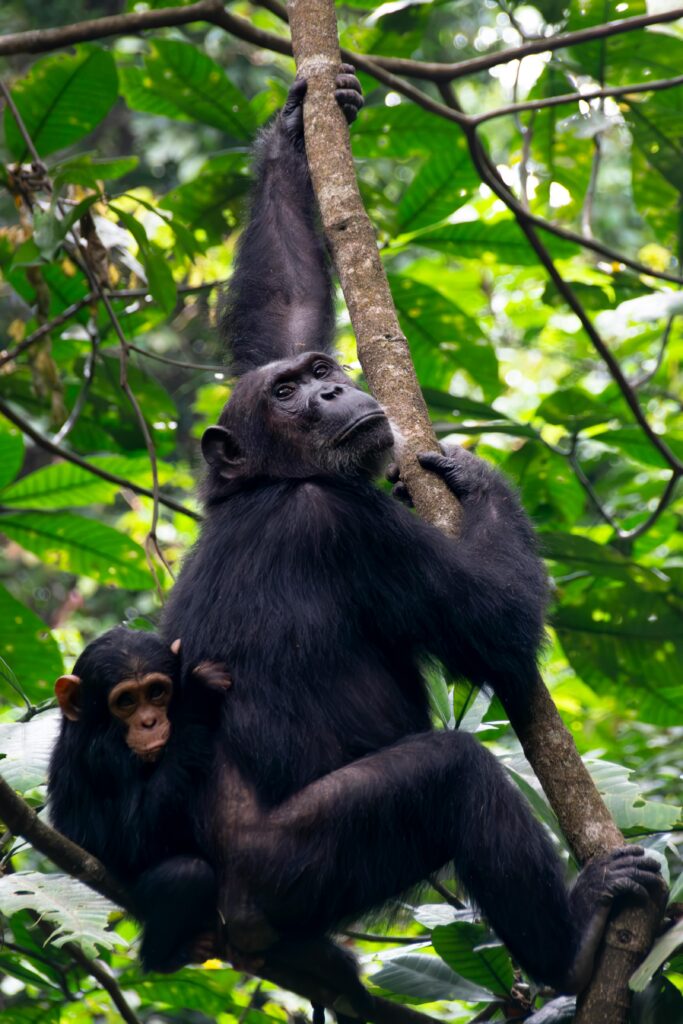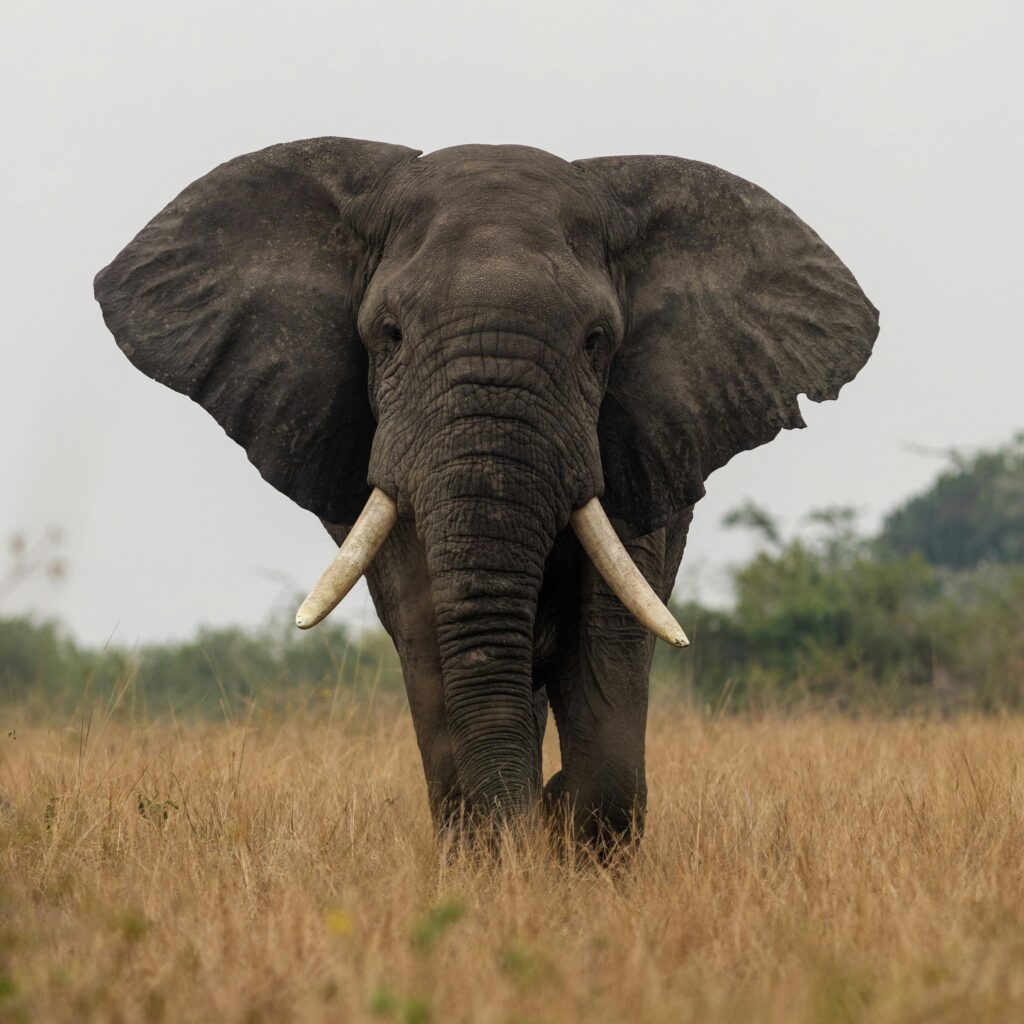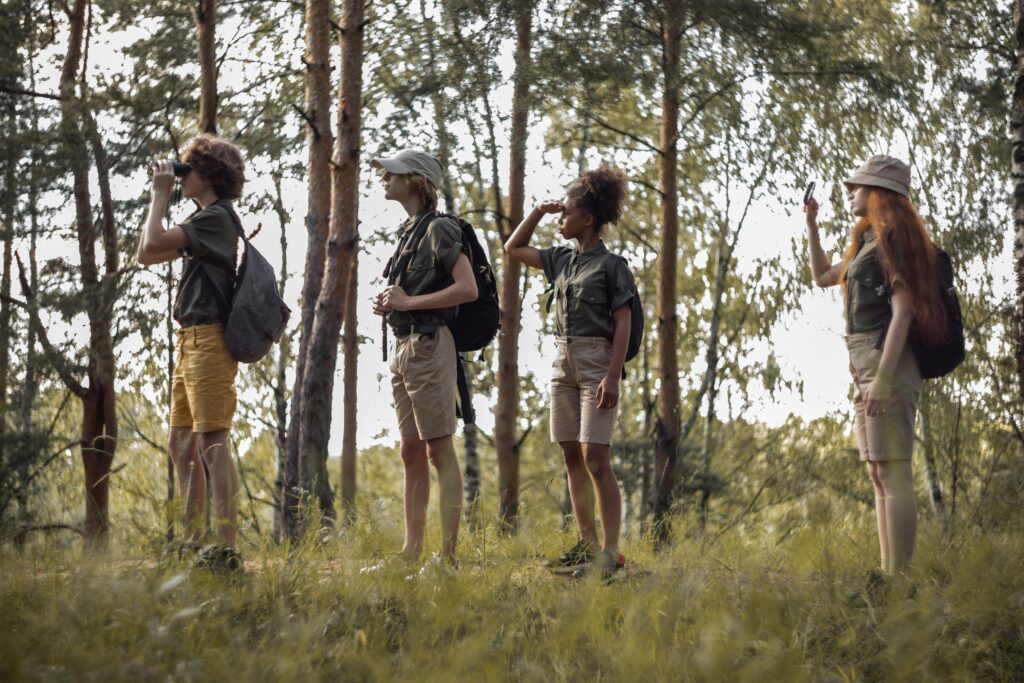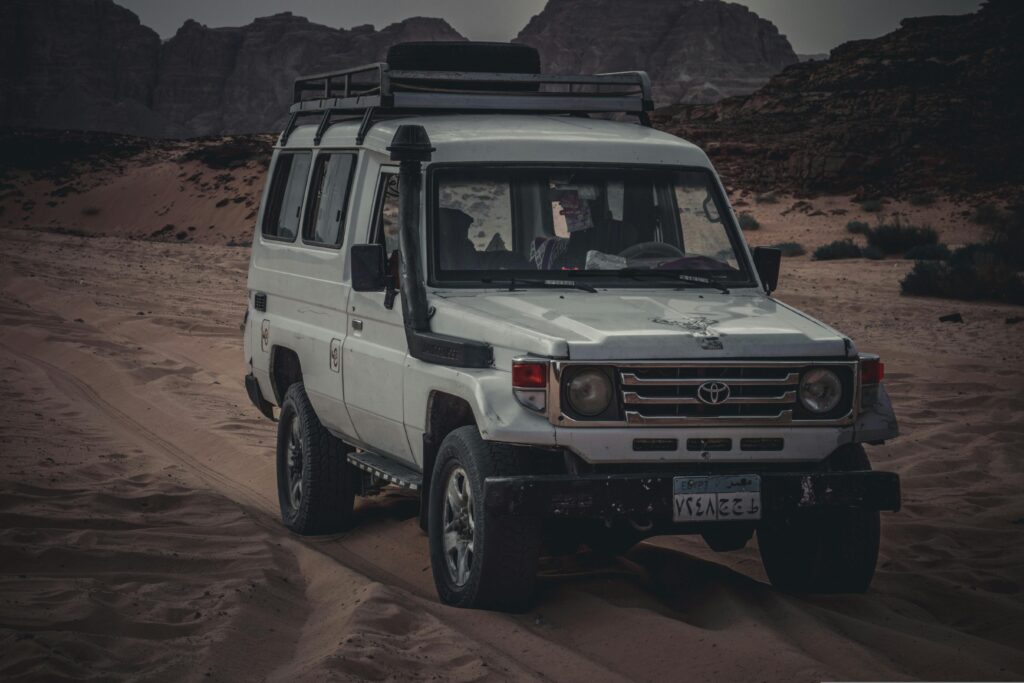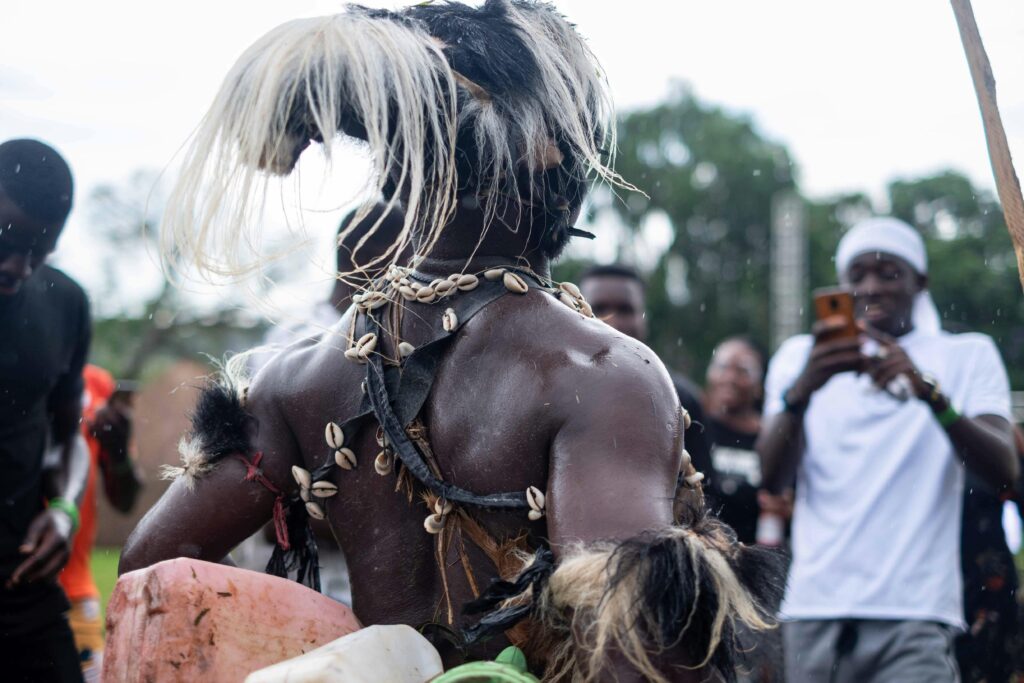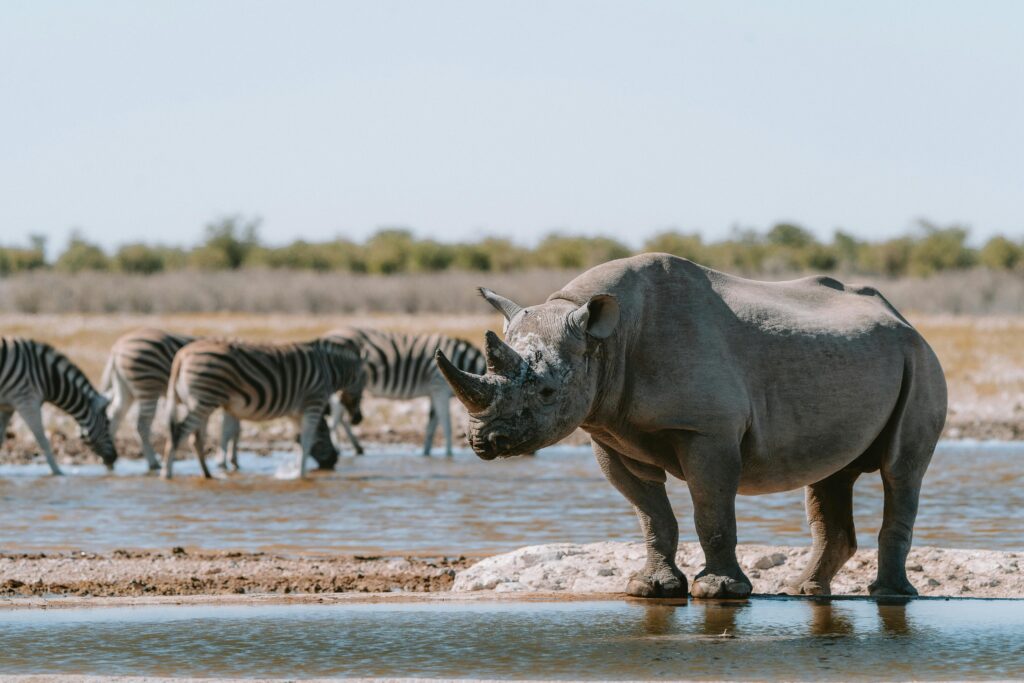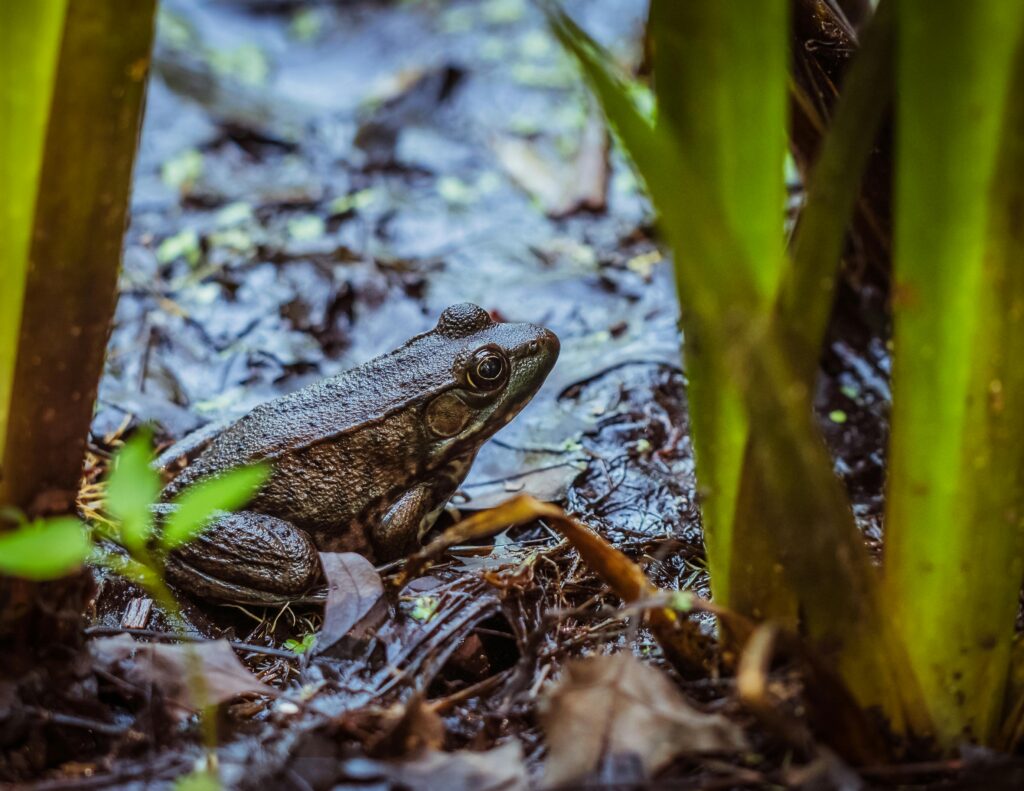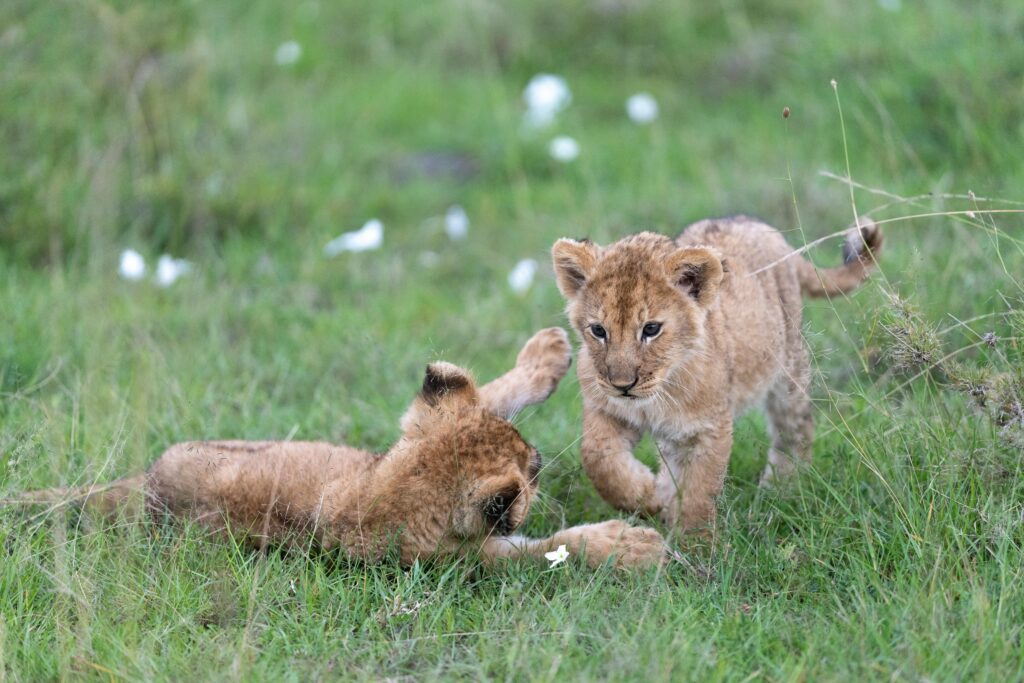Ultimate Uganda Safari and Gorilla Trekking
Have you ever fantasized about witnessing magnificent mountain gorillas walking freely in Africa’s verdant jungles?
Or maybe meeting chimpanzees, the closest relative of humans, has been at the top of your bucket list.
Only in Uganda can you witness two of Africa’s most unique and exciting sights simultaneously: one day you will be up close and personal with powerful silverback gorillas in foggy mountain woods, and the next day you will be in awe of rare tree-climbing lions relaxing like giant cats on old fig trees.
It is the pinnacle of wilderness immersion in Africa. Uganda has twelve designated wildlife reserves, each with unique animal populations and intricate topography.
To avoid losing out on the best sightings due to being in the wrong area at the wrong time, you must carefully arrange your itinerary.
By selecting the appropriate gorilla trekking location, you can avoid spending time on lengthy drives or needlessly hiking over kilometers of dense vegetation.
I’ll tell you all you need to know about organizing a safari in Uganda, so don’t worry. Based on my in-depth conversations with local experts and vast experience traveling throughout this nation.
It will take you at least seven days to see all of Uganda’s major reserves, based on my own experience. On the other hand, a 10-day itinerary will allow for a more leisurely pace and allow you to experience each place you visit.
Gorilla and chimpanzee trekking alone can get you by on as few as 5 days if you’re pressed for time and would rather concentrate your safari on primates.
You can complete this in three days if you’re only going to be tracking gorillas.
- Day 1: Entebbe and Kampala
- Day 2: Ziwa Rhino Sanctuary
- Day 3 Murchisons Fall National Park
- Day 4: Journey to Kibale(Bigodi Swamp Tour)
- Day 5: Chimpanzee Trekking (Kibale National Park)
- Day 6: Queen Elizabeth National Park
- Day 7: Drive to Bwindi Impenetrable Forest
- Day 8: Gorilla Trekking in Bwindi Impenetrable Forest
- Day 9: Lake Bunyonyi
- Day 10: Return to Entebbe with Equator Stop
Why go on a Safari in Uganda?
Perhaps the greatest and easiest location in Africa to witness critically endangered mountain gorillas and chimpanzees in their native habitat is Uganda. You have yourself a top-notch safari destination when you combine that with the possibility of seeing the majority of the Big Five—lions, leopards, elephants, and buffalo—in the wild!
An abundance of Parks and Reserves
The UWA oversees the nation’s ten national parks, twelve wildlife reserves, and fourteen wildlife sanctuaries. Rwenzori Mountain, Lake Victoria (the source of the Nile River), and Murchison Falls are a few of the most magnificent vistas.
Mountain Gorilla Trekking
It’s thrilling enough to see a herd of elephants or a pride of lions from the luxury of a safari truck, but witnessing a family of mountain gorillas with young on foot is an experience that cannot be compared. Gorillas are unable to survive in prison, so if you desire to come face-to-face with them, you’ll have to do it on their terms.
Approximately 459 of the world’s remaining 1000 wild mountain gorillas are located in Uganda’s Bwindi Impenetrable National Park. The Democratic Republic of the Congo, Rwanda, and Uganda are the only three nations in the world where mountain gorillas can be seen in their native habitat.
The cost of gorilla tracking in Uganda is reasonable; licenses for foreign visitors start at $800 per person. Compared to Rwanda’s permits, which run over $1,500 per person, this is a significant savings.
At $450, the Democratic Republic of the Congo is even less expensive. However, due to local insecurity, Virunga National Park, the DRC’s gorilla-tracking location, is currently closed to tourists.
Chimpanzee Trekking
The fact that there is more to see in Uganda than just gorillas is what truly sets it apart! There are also excellent chimpanzee tracking prospects here. There are approximately 1,500 chimpanzees in Kibale Forest National Park. Chimpanzees can also be seen in Kalinzu Forest, Kyambura Gorge, and Budongo Forest.
Compared to gorilla tracking, chimp tracking is less expensive. Permits for the world-renowned Kibale National Park cost $250, but those for lesser parks only cost $50.
The map I created below shows Kibale National Park, the best place to track chimpanzees.
Seeing the Big Five
Additionally, the majority of Africa’s Big Five—lions, leopards, elephants, and buffalo—can be seen in great numbers in Uganda. Although they are no longer seen in the wild due to poaching, rhinos can still be viewed in the Ziwa Rhino Sanctuary. The nation’s sole white southern rhinos can be found in Ziwa.
Flying Safari
The boating safari options offered in Queen Elizabeth and Murchison Falls National Parks further enhance Uganda’s variety of animal viewing options. Boat trips along jungle rivers provide a whole new approach to seeing animals and are particularly enjoyable for birdwatchers.
The shoebill, a big, ancient-looking bird that is indigenous to the marshes and wetlands of eastern and central Africa, is a rare bird that can only be seen in Uganda.
How to Book Your 10-Day Safari
Booking with a local tour operator is one of the most common and simple ways to go on safari in Uganda. I plan my safaris in Uganda in this manner, and I’m always delighted with the results.
These excursions are highly convenient because your tour operator takes care of everything, from booking lodging and obtaining permits to giving you the most up-to-date advice on where to go based on current wildlife activity.
Additional safari choices include fly-in safaris and self-drive safaris, which involve flying from lodge to lodge and include wildlife drives at each location. Package vacations, in which an international travel agency handles every aspect, including your overseas flights, are another choice.
The decision you choose will have a big impact on your safari adventure’s overall enjoyment and expense.
Option 1: Self-Drive
Adventurers on a tight budget who want to see Uganda might consider self-driving safaris. However, to get the most out of a self-driving safari, you must be comfortable with challenging driving conditions in a foreign nation and have a significant amount of off-road driving experience.
Option 2: Local Tour Operator
The best way to explore Uganda, in my opinion, is to plan your safari with a local tour operator. Apart from your international flights, local operators take care of every detail, guaranteeing a hassle-free and seamless trip from the moment you arrive until you depart. This method provides the most comprehensive and comfortable safari experience for many tourists.
Option 3: Hotel-Provided Safari
Many upscale safari resorts in Uganda, as well as many other African countries, have their safari game drives. If you wish to travel between lodges or would rather spend more time in one location, this type of safari may be suitable.
Because they offer a more upmarket means of exploring the area, these experiences are typically best suited for individuals with bigger incomes. Lodges can also help you arrange for gorilla tracking permits, which will make your trip planning easier.
Option 4: International Travel Agent
For people who don’t care about money and would rather have everything planned out, including overseas travel, this is the best choice. There are several potential disadvantages as well, but it’s crucial to remember that you will usually pay 25% to 40% more than if you made your reservation through a local tour operator.
Private vs Group Uganda Safari
Your total expenses will be greatly impacted by whether you are traveling alone or with others, but it will also affect how well your safari trip goes.
Instead of going with an outside group, I normally suggest going on a private safari. Let’s examine the benefits and drawbacks of each alternative.
Private Uganda Safari
For those seeking a more individualized and exclusive wildlife experience, private safaris in Uganda are the best option. My personal favorite, I suggest this option to most safari travelers, especially those who appreciate exclusivity and flexibility.
Group Safari
Solo travelers who want to meet new people and those on a very limited budget are the ideal candidates for shared safaris. Although less common, this choice might be suitable for people who value affordability above flexibility.
How Much Does a Uganda Safari Cost
For two adults sharing, a standard private Uganda safari that includes tracking chimpanzees and gorillas can start at $450 per person per day. To lower the average park fees per day, this price is based on a 7–10 day tour that includes one day each for tracking chimpanzees and gorillas, and the rest days spent on safari in national parks.
Your lodging, park admission, food, transportation, and all safari activities are included in this price. On the other hand, a shorter 3-day safari that includes two of the three days dedicated to tracking chimpanzees and gorillas costs $700 per person per day.
Shared group safaris start at about $350 per person per day, which is a little less expensive. However, the inevitable $800 per person gorilla tracking fees restrict the savings. Additionally, these excursions usually only provide simple camping accommodations. Although it’s not for everyone, this is an excellent choice for people who want a more gritty experience.
The costs listed above are based on direct reservations made with regional tour operators; if your trip is planned through an international travel agency, these costs may be much higher. If you want to see Uganda’s amazing wildlife at a lower cost, I highly suggest making reservations locally.
Uganda Safari Coast Breakdown
Let’s examine how your daily expenses are allocated throughout a safari in Uganda.Because gorilla and chimp tracking permits are so expensive ($800 and $250, respectively), park and permit fees account for the largest portion of expenses. On longer safaris, the high tracking costs are mitigated by the relatively inexpensive park fees (around $45 in the other reserves), which lowers the average cost per day.
The cost of the car and the driver’s guide comes in second. Although these expenses will make up somewhat more than 26% of your whole budget, having a knowledgeable local guide and a cozy, useful car are well worth the money.
Depending on the kind of lodging you select, your meals and lodging will make up about 18% of your daily costs. This estimate is based on cozy, mid-range lodge accommodations.
Fuel and bank fees take up about 4% of your budget each. The net profit of your tour operator accounts for somewhat more than 4% of your whole budget, with insurance and overheads totaling about 11%. If you made your reservation through an international travel agency, this percentage would be much greater.
Factors Affecting the Cost of a Uganda Safari
Your choice of lodging is the main determinant of the cost of your Uganda safari; premium accommodations are substantially more expensive than less expensive ones.
The way you reserve your safari might also have a big impact on the cost. For instance, using a local operator is usually less expensive than arranging through an international travel agency.
The number of days you spend gorilla tracking in Uganda is also important because permits for this sport are far more expensive than regular national park admission costs.
How to Book Your Ultimate Uganda Safari
Using foreign travel agencies or international safari firms to book your safari is unquestionably the most costly choice. The prices established by local operators, who are typically the ones doing the safari anyhow, are supplemented by these businesses’ profit margins.
Since there is no middleman and more competitive pricing is possible, booking directly with a local safari business typically offers the greatest value.
Because they take advantage of a captive market (you!), safaris offered by hotels can also be expensive. You could have to employ the hotel’s services, which are usually more expensive, if you haven’t planned your safari with a local operator beforehand.
Although self-driving safaris are marginally less expensive, you may miss out on numerous wildlife sights if you don’t have a guide.
Another less expensive option is a shared group safari, although there are drawbacks, such as less flexibility and fewer lodging choices.
Accommodation Comfort Level
The overall cost of your safari will be greatly influenced by the degree of comfort you select for your lodging, and there are several options available.
Lodges and tented camps are the most popular safari lodging alternatives in Uganda, and they are also reasonably priced when compared to other safari destinations.
There are choices to suit every taste and price range, from primitive camping to opulent lodgings.
The least expensive option is basic camping at private campgrounds, which costs $10 to $20 per person per night. Keep in mind that you won’t have air conditioning in your tent and that it may get hot in some areas of Uganda, including Murchison Falls, at certain times of the year!
While mid-range lodges, which cost $100 to $250 per person per night, offer a higher grade of amenities and nicer locations, budget lodges are more comfortable, costing between $40 and $100 per night.
At the highest end, the price range is fairly wide. Generally speaking, you can anticipate excellent service, stunning surroundings, and exceptional comfort at prices between $250 and $700+ per person each night. At its finest, tented camps and luxury lodges offer breathtaking vistas, fine food, and unique safari experiences that make their high cost justified.
Regardless of comfort level, accommodations that are close to important wildlife areas, especially those found in national parks or close to primate habitats, are typically more costly. Because of their prime positions, properties close to Queen Elizabeth National Park, Kibale Forest, or Bwindi Impenetrable Forest sometimes command premium prices.
Time of Year in Uganda Safari
The season you travel to Uganda has a big influence on how much you spend on your safari.
Because travel demand is at its maximum during peak seasons (June to September and December to February), you should anticipate paying premium rates for lodging. Excellent animal watching is available during these times, although the costs are greater.
Budget-conscious tourists can save money by traveling during off-peak times, even if some safari expenses, such as the sought-after gorilla and chimpanzee tracking licenses, are constant throughout the year.
Uganda’s national park entrance fees are consistently priced throughout the year, with the main parks like Queen Elizabeth and Murchison Falls charging $40–$45 per person per day. This differs from neighboring countries like Kenya, where park fees fluctuate seasonally.
Some of the more costly lodgings frequently offer discounts of up to 30–40% off peak season rates from March to May, when there is frequent rain. However, a lot of lodges also close during this time of year. It may be less expensive to travel during the long rainy season than at any other time of year, but I don’t advise it because of the high likelihood of difficulties with important activities like chimp and gorilla trekking.
How Many Days Do You Spend Gorilla & Chimpanzee Trekking
It may be less expensive to travel during the long rainy season than at any other time of year, but I don’t advise it because of the high likelihood of difficulties with important activities like chimp and gorilla trekking.
Because gorilla and chimpanzee tracking licenses are so expensive, park and permit costs in Uganda account for about 32 percent of your budget. These are $800 and $250 per person each day, respectively. This implies that your budget should increase to cover the cost of tracking chimps and gorillas for several days.
At about $45 per person per day, park fees in the other Ugandan reserves are, nevertheless, rather inexpensive. This price difference slightly evens things out and lowers your average daily park admission fee on longer safaris.
Mode of Transport between Parks
Your overall safari expenses may be significantly impacted if you decide to fly between parks. Since you are already paying for the game drive vehicle, which must move from one site to another anyhow, your transportation won’t be an extra expense if you are traveling by road between parks.
You can skip lengthy journeys on rough roads and drastically cut down on travel time by flying. When visiting multiple parks that are far apart, this mode of transportation is especially practical and lets you make the most of your time seeing animals.
Mode of Transport for Game Drives
Compared to other well-known safari locations like Kenya and Tanzania, Uganda offers a greater selection of vehicles.
The most affordable option is the regular minivan, which costs between $250 and $350 per day and includes a driver’s guide. Toyota Land Cruisers, on the other hand, cost an extra $100 per day and provide better off-road performance and comfort.
The cost of a land cruiser with a professional driver-guide usually ranges from $350 to $450 per day, and the entire group pays this amount. While they are usually all long wheelbase in other nations, Uganda offers a choice between variants with a shorter and longer wheelbase.
Specialized photographic land cruisers offer a better experience for serious photographers, with wider windows that open fully to maximize viewing angles. Additionally, a lot of these vehicles have beanbags, which aid in stabilizing the camera.
Group Size
The total cost of your safari might be significantly impacted by the size of your group. When compared to couples or groups traveling together, solo travelers usually incur the highest costs because they are responsible for paying for fixed items like the guide and the vehicle. The vacation becomes more cost-effective for everyone when these expenses are split among several participants. It’s recommended to keep your group size around seven people, though, as most private safari vehicles can only hold that many.
Best Time to Visit Uganda
The dry seasons, which run from June to September and December to February, are the ideal times to visit Uganda since they offer the highest chances for gorilla trekking and wildlife viewing.
Uganda is a year-round destination with generally decent weather during the remainder of the year, except for the intense rains that occur from March to May.
Uganda’s Unique Weather and Climate
Due to its proximity to some of Africa’s major lakes and mountains, Uganda suffers substantial regional climate differences despite its modest size and equatorial location. Temperature variations are largely influenced by elevation, with lower parts like Murchison being warmer and higher areas like Bwindi being colder.
The Important Role of Rain
The rains may also affect your vacation to Uganda, as they do in the majority of other safari locations in East or Central Africa.
The dry seasons, which vary in the northern and southern parts of the country, are the ideal times to visit Uganda.
There are two wet seasons (March–May and September–November) and two dry seasons (June–August and December–February) in the southern region.
Rainfall is still possible during the dry seasons, though, especially in places that are higher up or have forests. The northern area experiences a single, prolonged wet season (April through the end of November) and one lengthier dry season (December through the end of February). Even though the north experiences less rainfall than the south during its dry season, rain can still fall at any time.
Dry Season in South (June- August)
The months of June through August are the best times for tourists to explore reserves in southern Uganda, like Queen Elizabeth National Park, which is home to four of the Big Five and tree-climbing lions, and Bwindi Impenetrable National Park, which is well-known for gorilla tracking.
The south’s dry season occurs around this time, which makes it ideal for outdoor activities and animal observation.
Even though the driest months are June and July, rain showers might still happen occasionally.
The wet season in the north, which coincides with the dry season in the south, lasts from March to October. However, because of its semi-arid environment, the far north, which includes Kidepo Valley National Park, is mostly undisturbed by the rains, providing a distinctive and less crowded safari experience.
Dry Season Throughout Uganda (December – February)
Most visitors find that December through February is the ideal time to visit Uganda because it is the country’s dry season, which offers excellent chances to see wildlife.
With little rainfall, the weather in northern Uganda is especially pleasant, making it the perfect time of year to visit national parks like Kidepo Valley and Murchison Falls.
The hottest month of the year is February, and low-lying sites like Murchison Falls will be very scorching. Although unusual, I visited Murchison Falls in February and encountered temperatures of 40 degrees Celsius.
Even while they can still get more rain than during the June to August dry season, southern regions also have less rainfall than other periods of the year.
Light Rainy Season Throughout Uganda (September – November)
For those seeking a more sedate experience with still decent weather, September through November is a wonderful time to visit Uganda.
Light rain is expected during this time, although there is a chance of more intense downpours, particularly in the south. Trails might be muddy and challenging at times, but the scenery soon turns green, and by November, the countryside is covered in a carpet of wildflowers, which is a breathtaking sight to witness.
The majority of national parks remain open and brimming with wildlife. You may see the well-known tree-climbing lions in the Ishasha area of the famed Queen Elizabeth National Park. The gorillas in Bwindi Impenetrable Forest drop to lower altitudes, which facilitates sightings.
Long Rainy Season throughout Uganda (March – May)
Since the long rainy season begins in March and peaks in April, I wouldn’t advise most tourists to visit Uganda between March and May. Generally speaking, it is not a good time to travel to Uganda, either in the north or the south.
Budget travelers may find it appealing because lodges and tour companies offer certain discounts at this time of year. However, premium resorts typically offer the most savings on lodging.
Warm clothing is essential because evenings at higher elevations can get cold, even though daytime temperatures are pleasant and range from 16 to 28°C (61 to 82°F).
Although game viewing can be difficult during this season, wildlife is still abundant. Waterlogging makes many roads and paths impassable, and certain parks or lodges may momentarily.
How Long to Spend in Uganda
If you want to go on foot chimpanzee and mountain gorilla trekking and take part in some more traditional game drives, I would suggest staying in Uganda for at least seven days.
You will be able to travel more leisurely and experience each place if you have ten days to spare.
Five days is typically plenty for individuals who are primarily interested in primate encounters to cover both gorilla and chimpanzee tracking. You can complete this amazing adventure in as little as three days if gorilla trekking is your primary objective.
Uganda Border Crossing
Entebbe International Airport is the entry point for flights to Uganda. It is situated around 40 kilometers from Kampala, the country’s capital, close to the town of Entebbe.
Uganda’s principal international entry point and air traveler border station is Entebbe International Airport.
In addition to having several points of entry for overland travel, Uganda shares borders with South Sudan, Rwanda, Tanzania, Kenya, and the Democratic Republic of the Congo. The two border crossings with Kenya that are most often used are Malaba and Busia.
Particularly for visitors to Bwindi Impenetrable National Park, crossings from Rwanda, like Gatuna and Cyanika, as well as the Mutukula border with Tanzania and the Bunagana border with the DRC, are especially well-liked.
Although many visitors and residents cross the border at Bunagana without any issues, the general level of safety can vary based on the DRC’s security conditions. Additionally, you might want to stay away from South Sudanese borders.
Make sure you have all the necessary documents on hand, including your passport, yellow fever certificate, and any pertinent car documentation if you want to drive yourself, as border inspections can occasionally take a long time. Having some local money is also beneficial.
Uganda Visa
To enter Uganda, visitors from the USA, UK, and Europe need a visa. The cost of a tourist visa for one entrance is $50.It makes sense to apply for an East African tourist visa if you also intend to travel to Rwanda and/or Kenya. For 90 days from the date of issuance, this visa, which costs $100, permits multiple crossings into all three countries.
Uganda Vaccination
Upon arrival in Uganda, visitors must present documentation of their Yellow Fever vaccination. This must be completed at least ten days before your intended departure date, as it is a mandatory admission requirement.
Getting vaccinated against typhoid, rabies, and Hepatitis A and B is also optional but advised.
Uganda Medication
Given how common malaria is in Uganda, you might want to think about taking antimalarial medication. This should be arranged with your home travel clinic or regular healthcare physician. To prevent mosquito bites, it’s also critical to wear insect repellent and to cover oneself around twilight, dawn, and nighttime.
Additionally, as pharmacies are unlikely to be easily accessible when traveling, ensure you have an adequate supply of any regular or chronic prescriptions.
Uganda Currency
When visiting Uganda, it is advisable to have either US dollars (USD) or Ugandan shillings (UGX) on hand.
USD is generally accepted, particularly for larger expenditures such as hotel stays, safaris, gorilla permits, and tourism activities. Just make sure your notes are in decent shape and are more recent (after 2013). Additionally, using USD for tips is advised.
Only if you intend to visit neighborhood markets, tiny stores, and eateries outside of your accommodation will you need UGX instead of USD. Although most restaurants accept credit and debit cards, there may be a currency conversion cost.
Local currency is available at ATMs and forex bureaus. However, big towns and cities like Kampala, Entebbe, and others are typically the only places where ATMs and forex bureaus are available.
10-Day Uganda Safari Overview
Based on my extensive research on the subject and my own experience, I have created the ideal 10-day Uganda safari itinerary below.
To create the most pleasurable schedule, I have also taken driving times and the distance between the parks into account.
Day 1- Entebbe & Kampala
When you land at Entebbe International Airport, Uganda’s primary international airport, your 10-day journey around the country begins. It is roughly 40 kilometers (25 miles) away from the capital, Kampala.
You have the option of starting your safari tour right away or arriving a day or two early for a more leisurely experience. This will give you more time to get used to the relaxed atmosphere of Africa and provide you with the opportunity to see Entebbe and Kampala.
To transport you to your resort in the vibrant, bustling city of Kampala or the surrounding area of Entebbe, your tour operator will be waiting for you at the airport.
After your lengthy journey, you can spend the remainder of the day lounging at your lodge and stretching your legs, or you can tour Entebbe and Kampala, depending on when you arrive.
Day 2- Ziwa Rhino Sanctuary
Once you’re there, you’ll start walking to catch a first look at one of the world’s most endangered animal species. In Uganda, rhinos are a protected species and cannot be seen in the wild due to frequent poaching. Since the sanctuary is only 70 km² in size, you will undoubtedly see lots of rhinos on your walking safari with these gentle giants.
You will drive to Murchison Falls for a couple of hours after spending some time with the rhinos. You will exit your car at the end of the trip to take in the views of the falls. After a long day of moving around, standing in the spray is a terrific way to calm down.
Day 3 – Murchison Falls National Park
After a thrilling boat ride on the Nile River this morning, you’ll go on a game drive in the park.
You will go through a variety of environments during your game drive, including riverine woods, dense woodlands, and open grasslands. A remarkable variety of animals can be found in these varied settings taken together.
There are chimpanzees, baboons, giraffes, warthogs, hyenas, lions, leopards, elephants, buffalo, chimpanzees, colobus monkeys in black and white, and red-tailed monkeys. Herds of Uganda kob, hartebeest, and numerous other antelope species will also be encountered.
Arriving on the banks of the Nile, the longest river in the world, and hearing the thunderous roar of the magnificent Murchison Falls before you even see them may be the high point of the day.
The opportunity to glide over the stream while admiring the falls from above is provided by the afternoon river cruise. Crocodiles may be cruising the channels or relaxing on the banks, while groups of hippos may be wallowing in the shallows.
Bird lovers will be in their element because the area around the river is home to around 500 different species of birds. The goliath heron, fish eagles, crested cranes, blue-headed coucals, kingfishers, Abyssinian ground hornbills, saddle-billed stork, and the incredibly uncommon and ancient-looking shoebill stork are among the species to keep an eye out for. This character’s bill, which is thought to resemble a Dutch clog, is where it got its name.
Day 4- Journey to Kibale (Bigodi Swamp Tour)
You’ll go on a very lengthy drive of almost five hours after breakfast. You will ultimately reach your lodge or tented camp just outside of Kibale National Park after traveling through the stunning African landscape, which is peppered with farmlands and rural settlements.
A guided walking tour of the Bigodi Swamp, a stunning section of the rainforest that is teeming with wildlife, will begin when you arrive. You can spot a variety of birds and monkeys, as well as, if you’re lucky, forest elephants! You will have a good idea of what to expect on your monkey tracking excursion in the morning from this walk through the Bigodi wetlands.
Day 5: Chimpanzee Trekking (Kibale National Park)
You will embark on your first chimpanzee excursion on foot following an early breakfast. Depending on where the chimps are most likely to be, the trek should take two to three hours. You will be led through the forest by your guide, who should be able to locate a troop very quickly (it took me almost two hours), and allow you to spend at least an hour watching them swing through the trees and engage with one another.
Your guide will also impart their extensive knowledge of the forest’s diverse plant life, which includes over 350 different tree species, and the roles that each one plays in this complex ecosystem.
After your return, you will eat lunch at your resort. After that, you have the option of relaxing in the afternoon or touring Fort Portal, a tiny city located on the park’s northwest edge.
Day 6: Queen Elizabeth National Park
You will have a picturesque drive to Queen Elizabeth National Park following breakfast at Kibale National Park. After lunch, which you will arrive just in time for, there will be a game drive in the afternoon.
Given the enormous diversity and high density of animal species in the park, your game drive is probably going to be an exciting one. In addition to hyenas, warthogs, waterbuck, impalas, the native Uganda kob, and numerous other antelope and primate species, lions, leopards, elephants, and buffalo are frequently sighted.
Day 7: Drive to Bwindi Impenetrable Forest
Following breakfast, you will embark on a lengthy but picturesque journey across the park, passing through the Kigezi Game Reserve and approaching the Ishasha region while admiring the wildlife and breathtaking scenery. You can get from point A to point B with this spectacular trip, but it’s also a fantastic gaming drive in and of itself!
The best spot to see Queen Elizabeth Park’s renowned tree-climbing lions is in the Ishasha sector. This area is located in the park’s southernmost section, which borders the Democratic Republic of the Congo.
Like their distant cousins in the Kalahari way down south in Botswana, some male lions in the Ishasha region have long black manes that make them appear even more majestic and powerful.
Elephants, leopards, and herds of several antelope species, such as the Uganda kob, which is the big cats’ preferred prey, are among the other creatures you might see here.
After driving through Ishasha, you will continue to the impenetrable forest of Bwindi. The park is divided into four sectors: Ruhija (Northeast), Nkuringo (South), Rushaga (Southwest), and Buhoma (Central). The sector in which you will be stationed for your gorilla trekking excursion will determine how long your drive will take. Rushaga is
Day 8: Gorilla Trekking in Bwindi Impenetrable Forest
Since you have to be at your briefing location by 7:30 am, your day starts rather early. Here, your guide will lay out a rigorous set of guidelines that you must adhere to during the day’s hike. Your guide will lead a party of up to eight individuals as they search for a particular gorilla family.
The journey may take two to six hours, depending on the gorillas’ location. You will be given approximately an hour to spend with the group after you have located them. You’ll receive instructions on how to act around them and how close you can approach them. Generally speaking, you should distance yourself from them by about 7 meters (23 feet).
Trekking takes a respectable level of fitness and can be somewhat taxing for many people. The terrain can also be difficult because it is primarily uphill through dense forest foliage, warm, humid, and possibly muddy in some places.
You will return to the briefing area after spending an hour watching the gorillas.
You will have the opportunity to learn about the Batwa (also called Twa) Pygmies during an optional cultural visit to a Batwa community in the afternoon if you complete your gorilla trekking promptly and still have energy for more.
Before being forced out when the region was declared a national park in 1991, these indigenous forest peoples had resided in the Bwindi Impenetrable Forest for thousands of years. Some Batwa towns have attempted to address the numerous difficulties that the Batwa people still face as a result of their displacement by offering cultural tourism experiences.
You can also take part in a gorilla habituation session, where you will join a team of rangers and researchers on a training exercise and get to interact with gorillas, if your visit to the gorilla families leaves you wanting a closer experience. The goal of habitat programs is to acclimate gorillas to humans over three years.
For critically endangered gorillas, this has the benefit of enabling more frequent population monitoring, veterinarian interventions when necessary, and less stress for the animals when they interact with tourists. Only during training programs is it possible to take part in a habituation session, which is an optional extra.
Day 9: Lake Bunyonyi
Following breakfast, you bid farewell to the majestic residents of the misty mountains of the Bwindi Impenetrable Forest and begin a three-hour drive south to the picturesque Lake Bunyonyi.
You can choose how you want to spend the day in and around the lake once you get there. Here, you have countless alternatives. The lake is safe to enjoy at your leisure because it is devoid of hippos, crocs, and waterborne diseases.
You can zip-line across a canyon, swim, kayak, go on a boat cruise on the lake, or explore an island, go on a boat birding safari, go mountain biking, or spend the day sampling the local cuisine at the numerous lodges and eateries dotting the islands and the lakeshore. Delicious freshwater crayfish is the lake’s most well-known specialty dish. These crustaceans, which are now known as Lake Bunyonyi crayfish, were brought to this area from Louisiana a few years ago.
Day 10: Return to Entebbe with Equator Stop
You start your journey to Entebbe, which will take the majority of the day, after breakfast at your resort near Lake Bunyonyi. After arriving in Masaka, you head north, making a stop at the Uganda Equator Crossing Monument in the village of Kayabwe.
It will take you another two hours to drive to Entebbe or Kampala once you enter the Northern Hemisphere.
Final Thoughts
Uganda is a safari place unlike any other. The natural surroundings are breathtaking, ranging from immaculate, mirror-like lakes to deep African jungles. However, encountering our close relatives, the great primates, up close reveals the genuinely unique character of this nation.
When you witness a mountain gorilla mother holding her young with tenderness, nothing can prepare you for the eerie sense of familiarity and amazement that follows. Or the way young chimpanzees interact with one another in such a spontaneous and loving way that is so human-like.
Uganda’s national park entrance fees are consistently priced throughout the year, with the main parks like Queen Elizabeth and Murchison Falls charging $40–$45 per person per day. This differs from neighboring countries like Kenya, where park fees fluctuate seasonally.
Although visiting during the long rainy season might be cheaper than any other time of the year, I don’t recommend this as the heavy rainfall is likely to make key activities, like gorilla and chimp trekking, quite more challenging.

